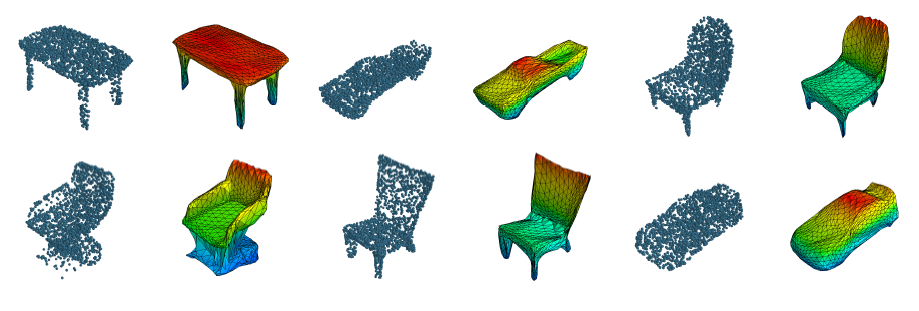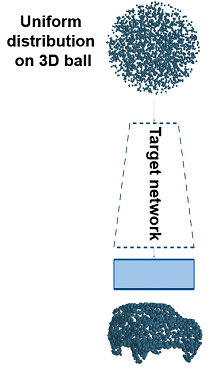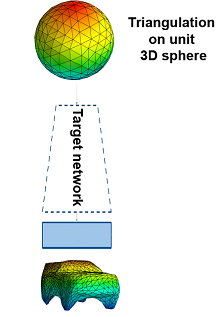Authors: Przemysław Spurek, Sebastian Winczowski, Jacek Tabor, Maciej Zamorski, Maciej Zįeba, Tomasz Trzcínski
| arXiv |
|---|
| Hypernetwork approach to generating point clouds (abs) |
| Hypernetwork approach to generating point clouds (pdf) |
| ICML 2020 |
|---|
| Hypernetwork approach to generating point clouds (abs) |
| Hypernetwork approach to generating point clouds (pdf) |
In this work, we propose a novel method for generating 3D point clouds that leverage properties of hyper networks. Contrary to the existing methods that learn only the representation of a 3D object,our approach simultaneously finds a representation of the object and its 3D surface. The main idea of our HyperCloud method is to build a hyper network that returns weights of a particular neural network (target network) trained to map points from a uniform unit ball distribution into a 3D shape. As a consequence, a particular 3D shape can be generated using point-by-point sampling from the assumed prior distribution and transform-ing sampled points with the target network. Since the hyper network is based on an auto-encoder architecture trained to reconstruct realistic 3D shapes, the target network weights can be considered a parametrization of the surface of a 3D shape, and not a standard representation of point cloud usually returned by competitive approaches.The proposed architecture allows finding mesh-based representation of 3D objects in a generative manner while providing point clouds en pair in quality with the state-of-the-art methods.
- dependencies stored in
requirements.txt. - Python 3.6+
- cuda
If you are using Conda:
- run
./install_requirements.sh
otherwise:
- install
cudatoolkitand runpip install -r requirements.txt
Then execute:
export CUDA_HOME=... # e.g. /var/lib/cuda-10.0/
./build_losses.sh
- arch -> aae | vae
- target_network_input:normalization:type -> progressive
- target_network_input:normalization:epoch -> epoch for which the progressive normalization, of the points from uniform distribution, ends
- reconstruction_loss -> chamfer | earth_mover
- dataset -> shapenet
"save_weights_frequency": int (> 0) -> save model's weights every x epochs
"save_samples_frequency": int (> 0) -> save intermediate reconstructions every x epochs
3D points are sampled from uniform distribution.
When normalization is enabled, points are normalized progressively
from first epoch to target_network_input:normalization:epoch epoch specified in the configuration.
As a result, for epochs >= target_network_input:normalization:epoch, target network input is sampled from a uniform unit 3D ball
Exemplary config:
"target_network_input": {
"constant": false,
"normalization": {
"enable": true,
"type": "progressive",
"epoch": 100
}
}
For epochs: [1, 100] target network input is normalized progressively
For epochs: [100, inf] target network input is sampled from a uniform unit 3D ball
Add project root directory to PYTHONPATH
export PYTHONPATH=project_path:$PYTHONPATH
python experiments/train_[aae|vae].py --config settings/hyperparams.json
Results will be saved in the directory:
${results_root}/[aae|vae]/training/uniform*/${dataset}/${classes}
python experiments/experiments.py --config settings/experiments.json
Results will be saved in the directory:
${results_root}/[aae|vae]/experiments/uniform*/${dataset}/${classes}
Model weights are loaded from path:
- ${weights_path} if specified
- otherwise: ${results_root}/${arch}/training/.../weights (make sure that
target_network_inputandclassesare the same in thehyperparams.json/experiments.json)
The following experiments provide input of the target network as samples from a triangulation on a unit 3D sphere:
sphere_trianglessphere_triangles_interpolation
3D points are sampled uniformly from the triangulation on a unit 3D sphere.
Available methods: hybrid | hybrid2 | hybrid3 | midpoint | midpoint2 | centroid | edge
python experiments/compute_metrics.py --config settings/experiments.json
Model weights are loaded from path:
- ${weights_path} if specified
- otherwise: ${results_root}/${arch}/training/.../weights (make sure that
target_network_inputandclassesare the same in thehyperparams.json/experiments.json)
Classes can be specified in the hyperparams/experiments file in the classes key
airplane, bag, basket, bathtub, bed, bench,
bicycle, birdhouse, bookshelf, bottle, bowl, bus,
cabinet, can, camera, cap, car, chair,
clock, dishwasher, monitor, table, telephone, tin_can,
tower, train, keyboard, earphone, faucet, file,
guitar, helmet, jar, knife, lamp, laptop,
speaker, mailbox, microphone, microwave, motorcycle, mug,
piano, pillow, pistol, pot, printer, remote_control,
rifle, rocket, skateboard, sofa, stove, vessel,
washer, boat, cellphone
This implementation is licensed under the MIT License


